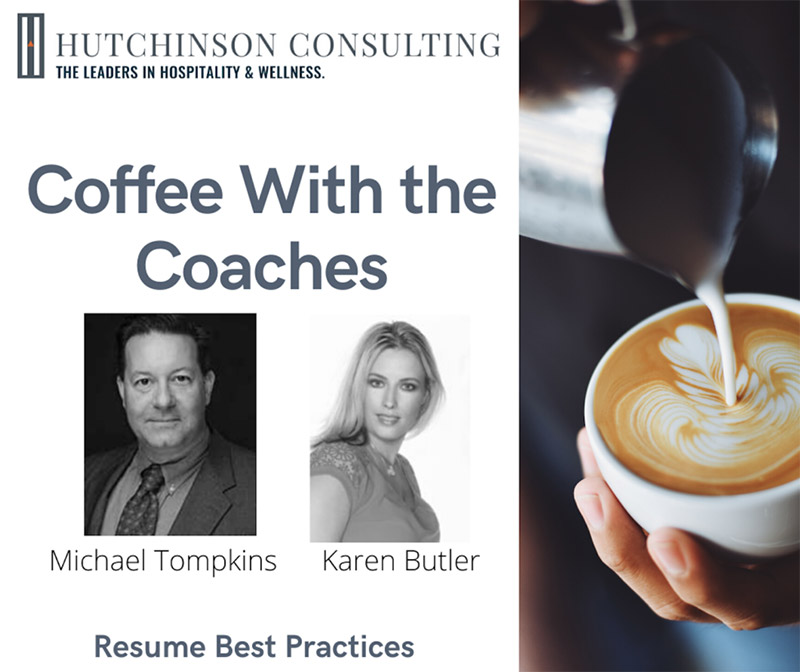The highly anticipated second episode of Coffee With the Coaches, featuring Michael Tompkins and Karen Butler, focused on creating the best version of your resume. If you missed the live session, listen here:
The session was so popular, we will be adding another Coffee With the Coaches resume session, taking place May 20 at 1 pm ET. Michael and Karen will be joined by executive recruiter Julie Ambrosini for another powerful session. Register here.
Additionally, here are some important takeaways and action items from Michael and Karen’s conversation.
Elements of a Resume To Set you Apart
There are four key elements of a resume:
- Header: Your name, home town and contact information (cell phone, personal/professional email address) at the top of the first page. We recommend you not include your street address, but include your city/town and state. Zip code is also not necessary.
- Professional Experience: We suggest a chronological format, starting with your current/most recent position and working in descending order.
- Education: Be sure to include any relevant training and ongoing education.
- Professional or Industry Associations/Honors/Recognition/Activities: List associations of which you are a member. Include any awards or special recognition you have received.
Compose a resume with every detail written with the reader in mind. Don’t attempt to create a resume in an hour. Compose your resume over at least a few day so you can close the document and view it later with fresh eyes. Tell an honest story in your resume – don’t overstate, stretch the truth, or fabricate even one word.
Accomplishments Detailed for Each Position
After listing your employer, position, and years of service consider having three distinct parts describing the most recent positions on your resume.
The first part is the company’s facts. List the Position title, Company name, and dates, including months of employment.
The second part is a description of your primary responsibilities with factual details. For instance:
- Managed 42 Spa Providers; was responsible for scheduling, training, disciplining, hiring, and dismissing.
The third and most important part consists of your accomplishments. Examples:
- Created and implemented comprehensive training program which helped to increase guest service scores by 30 points between 2009 and 2010.
- Increased top-line revenue by 18% from 2018 to 2019.
Overall Visually Pleasing Look – Crisp and Clean
The reader spends about one minute scanning your resume and will disconnect from reading it if the reader is bored or, worse, unimpressed. If your resume is too long or too difficult to read easily, chances are it won’t be read even for one minute.
Other offenses include using the wrong tense, thereby disconnecting the reader, too many long sentences, being verbose, too many subjective comments, and not enough objective facts.
Don’t use a template. Use your own simple and easy-to-read style. Strive for brevity so that you can keep your resume to two pages or less.
Make certain you carefully proofread your resume for accuracy. Involve trusted and detail oriented friends to review your resume.
Details, Details, and MORE Details
- Provide starting and ending dates (months and years) for each position: “March 2009 to December 2010”.
- Don’t include a list of core competencies or strengths or subjects mastered. Such a list is subject to criticism, because it is a subjective list of your own creation.
- Use a personal (but professional) email address separate from the email address you have at work. Choose an email address you can use for years. An example would be JaneDoe@gmail.com.
- Check spelling of every word, including prior employers.
- Spell out all words – January not Jan or Jan.; Avenue not Ave. The only exceptions are the names of states: two capital letters with no period – CA, NY, etc.
- Don’t use personal pronouns: I, me or my.
- Don’t include your photograph (unless you are outside of the United States).
- Be careful about page breaks. Make sure you don’t have an extra page at the end that will print blank. Avoid splitting a company or a position onto two pages.
- Use a header to show your name and the page number on each page, with the exception of the first page, of course.
- Name and save your document with your name, such as “Doe, Jane resume” not “resume second version”, (which also implies multiple versions).
- Use active verbs (manage, create, administer). Use present verb tense for your current position and past verb tense for former positions. For a past position it is better to state “was responsible for” than to say “responsible for”.
- Don’t include your date of birth or the date of your high school or college graduation.
- Don’t include a list of references with a resume. When you are asked for a reference list, provide a description of your working relationship with each individual and the individual’s contact information. Provide at least three people you reported to previously.
- If you struggle with your writing skills, don’t hesitate to get assistance. There are many websites with great advice, key words, and examples to draw from. And when all else fails, use the services of a professional resume writer.
Join us for our next editions of Coffee With the Coaches, which take place each Wednesday at 1 pm ET. Topics and registration links are available here.



